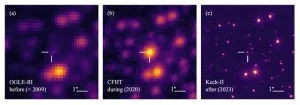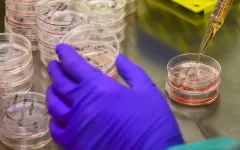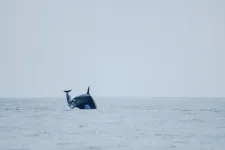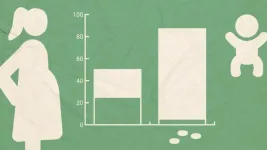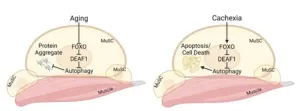(Press-News.org) The discovery of an Earth-like planet 4,000 light years away in the Milky Way galaxy provides a preview of one possible fate for our planet billions of years in the future, when the sun has turned into a white dwarf, and a blasted and frozen Earth has migrated beyond the orbit of Mars.
This distant planetary system, identified by University of California, Berkeley, astronomers after observations with the Keck 10-meter telescope in Hawaii, looks very similar to expectations for the sun-Earth system: it consists of a white dwarf about half the mass of the sun and an Earth-size companion in an orbit twice as large as Earth’s today.
That is likely to be Earth’s fate. The sun will eventually inflate like a balloon larger than Earth's orbit today, engulfing Mercury and Venus in the process. As the star expands to become a red giant, its decreasing mass will force planets to migrate to more distant orbits, offering Earth a slim opportunity to survive farther from the sun. Eventually, the outer layers of the red giant will be blown away to leave behind a dense white dwarf no larger than a planet, but with the mass of a star. If Earth has survived by then, it will probably end up in an orbit twice its current size.
The discovery, to be published this week in the journal Nature Astronomy, tells scientists about the evolution of main sequence stars, like the sun, through the red giant phase to a white dwarf, and how it affects the planets around them. Some studies suggest that for the sun, this process could begin in about 1 billion years, eventually vaporizing Earth's oceans and doubling Earth's orbital radius — if the expanding star doesn't engulf our planet first.
Eventually, about 8 billion years from now, the sun's outer layers will have dispersed to leave behind a dense, glowing ball — a white dwarf — that is about half the mass of the sun, but smaller in size than Earth.
"We do not currently have a consensus whether Earth could avoid being engulfed by the red giant sun in 6 billion years," said study leader Keming Zhang, a former doctoral student at the University of California, Berkeley, who is now an Eric and Wendy Schmidt AI in Science Postdoctoral fellow at UC San Diego. "In any case, planet Earth will only be habitable for around another billion years, at which point Earth's oceans would be vaporized by runaway greenhouse effect — long before the risk of getting swallowed by the red giant."
The planetary system provides one example of a planet that did survive, though it is far outside the habitable zone of the dim white dwarf and unlikely to harbor life. It may have had habitable conditions at some point, when its host was still a sun-like star.
"Whether life can survive on Earth through that (red giant) period is unknown. But certainly the most important thing is that Earth isn't swallowed by the sun when it becomes a red giant," said Jessica Lu, associate professor and chair of astronomy at UC Berkeley. “This system that Keming's found is an example of a planet — probably an Earth-like planet originally on a similar orbit to Earth — that survived its host star's red giant phase.”
Microlensing makes star brighten a thousandfold
The far-away planetary system, located near the bulge at the center of our galaxy, came to astronomers' attention in 2020 when it passed in front of a more distant star and magnified that star's light by a factor of 1,000. The gravity of the system acted like a lens to focus and amplify the light from the background star.
The team that discovered this "microlensing event" dubbed it KMT-2020-BLG-0414 because it was detected by the Korea Microlensing Telescope Network in the Southern Hemisphere. The magnification of the background star — also in the Milky Way, but about 25,000 light years from Earth — was still only a pinprick of light. Nevertheless, its variation in intensity over about two months allowed the team to estimate that the system included a star about half the mass of the sun, a planet about the mass of Earth and a very large planet about 17 times the mass of Jupiter — likely a brown dwarf. Brown dwarfs are failed stars, with a mass just shy of that required to ignite fusion in the core.
The analysis also concluded that the Earth-like planet was between 1 and 2 astronomical units from the star — that is, about twice the distance between the Earth and sun. It was unclear what kind of star the host was because its light was lost in the glare of the magnified background star and a few nearby stars.
To identify the type of star, Zhang and his colleagues, including UC Berkeley astronomers Jessica Lu and Joshua Bloom, looked more closely at the lensing system in 2023 using the Keck II 10-meter telescope in Hawaii, which is outfitted with adaptive optics to eliminate blur from the atmosphere. Because they observed the system three years after the lensing event, the background star that had once been magnified 1,000 times had become faint enough that the lensing star should have been visible if it was a typical main-sequence star like the sun, Lu said.
But Zhang detected nothing in two separate Keck images.
"Our conclusions are based on ruling out the alternative scenarios, since a normal star would have been easily seen," Zhang said. "Because the lens is both dark and low mass, we concluded that it can only be a white dwarf."
"This is a case of where seeing nothing is actually more interesting than seeing something," said Lu, who looks for microlensing events caused by free-floating stellar-mass black holes in the Milky Way.
Finding exoplanets through microlensing
The discovery is part of a project by Zhang to more closely study microlensing events that show the presence of a planet, in order to understand what types of stars exoplanets live around.
"There is some luck involved, because you'd expect fewer than one in 10 microlensing stars with planets to be white dwarfs," Zhang said.
The new observations also allowed Zhang and colleagues to resolve an ambiguity regarding the location of the brown dwarf.
“The original analysis showed that the brown dwarf is either in a very wide orbit, like Neptune's, or well within Mercury’s orbit. Giant planets on very small orbits are actually quite common outside the solar system,” Zhang said, referring to a class of planets called hot Jupiters. “But since we now know it is orbiting a stellar remnant, this is unlikely, as it would have been engulfed.”
The modeling ambiguity is caused by so-called microlensing degeneracy, where two distinct lensing configurations can give rise to the same lensing effect. This degeneracy is related to the one Zhang and Bloom discovered in 2022 using an AI method to analyze microlensing simulations. Zhang also applied the same AI technique to rule out alternative models for KMT-2020-BLG-0414 that may have been missed.
"Microlensing has turned into a very interesting way of studying other star systems that can't be observed and detected by the conventional means, i.e. the transit method or the radial velocity method," Bloom said. "There is a whole set of worlds that are now opening up to us through the microlensing channel, and what's exciting is that we're on the precipice of finding exotic configurations like this."
One purpose of NASA's Nancy Grace Roman Telescope, scheduled for launch in 2027, is to measure light curves from microlensing events to find exoplanets, many of which will need follow up using other telescopes to identify the types of stars hosting the exoplanets.
"What is required is careful follow up with the world's best facilities, i.e. adaptive optics and the Keck Observatory, not just a day or a month later, but many, many years into the future, after the lens has moved away from the background star so you can start disambiguating what you're seeing," Bloom said.
Zhang noted that even if Earth gets engulfed during the sun's red giant phase in a billion or so years, humanity may find a refuge in the outer solar system. Several moons of Jupiter, such as Europa, Callisto and Ganymede, and Enceladus around Saturn, appear to have frozen water oceans that will likely thaw as the outer layers of the red giant expand.
"As the sun becomes a red giant, the habitable zone will move to around Jupiter and Saturn's orbit, and many of these moons will become ocean planets," Zhang said. "I think, in that case, humanity could migrate out there."
Other co-authors are Weicheng Zang and Shude Mao of Tsinghua University in Beijing, China, who co-authored the first paper about KMT-2020-BLG-0414; former UC Berkeley doctoral student Kareem El-Badry, now an assistant professor at the California Institute of Technology in Pasadena; Eric Agol of the University of Washington in Seattle; B. Scott Gaudi of The Ohio State University in Columbus; Quinn Konopacky of UC San Diego; Natalie LeBaron of UC Berkeley; and Sean Terry of the University of Maryland in College Park.
END
This rocky planet around a white dwarf resembles Earth — 8 billion years from now
Existence of Earth-like planet around dead sun offers hope for our planet's ultimate survival
2024-09-26
ELSE PRESS RELEASES FROM THIS DATE:
Study finds more than 80% of women iron deficient by third trimester
2024-09-26
Rockville, MD ̶ ̶ When a woman becomes pregnant, her iron requirements increase almost tenfold to support fetal development as well as her own increased iron needs. Her ability to meet these increased iron needs depends on her iron stores at the beginning of the pregnancy as well as the physiological adaptations that enhance iron absorption as pregnancy progresses. These physiological adaptations, however, are not always enough to support a pregnant woman’s iron needs, especially ...
4 in 5 pregnant women in Ireland are iron deficient by third trimester, study finds
2024-09-26
Four out of five pregnant women in Ireland are iron deficient by their third trimester, a University College Cork (UCC) study reveals. Researchers at the Irish Centre for Maternal and Child Health (INFANT) and School of Food and Nutritional Sciences in UCC have shown that over 80% of women are iron deficient by their third trimester.
The findings raise concerns as the participants in the study were a low-risk and generally healthy cohort. Iron deficiency during pregnancy is linked to increased risks of complications for both mother and child, including neurodevelopmental challenges for the baby.
This study is the largest of its kind globally and was ...
Researchers identify antibodies against Klebsiella pneumoniae
2024-09-26
Research at UMC Utrecht has identified 29 novel antibodies against the bacterium Klebsiella pneumoniae, an important cause of drug-resistant infections. Using genetic and functional approaches, the researchers also managed to unravel how these antibodies interact with antigens on the bacterial surface. Finally, they found that some of these novel antibodies act synergistically to neutralize this pathogen.
The increasing problem of antimicrobial resistance (AMR) urgently calls for the development of alternative ...
Housing, healthcare and social services top list of community needs as U.S. population ages
2024-09-26
WASHINGTON, D.C. — Sept. 26, 2024 — Most Americans agree their community is in need of more affordable housing, healthcare and social supports and services to help residents remain living independently as they age, according to a new survey from West Health and Gallup. Sixty-five percent of Americans perceive a need for more affordable housing and 60% say there is a need for more affordable healthcare and social supports and services.
The new West Health-Gallup research comes as the ...
Mysterious orca group near Chile tracked down, revealing newly discovered hunting skills
2024-09-26
Off the coast of Chile, in waters filled with krill and anchovy by the Humboldt Current system, live an elusive and little-known population of orcas. Thanks to citizen science and years of dedicated surveillance, a team of scientists led by Dr Ana García Cegarra of the Universidad de Antofagasta are unveiling their secrets — starting with dinner.
García Cegarra’s team, who previously observed these orcas using fishing boats to help them capture sea lions, have now spotted them successfully hunting dusky dolphins for the first time and sharing the food among the pod. This new evidence about their eating habits may help experts understand how populations ...
Treatment for major cause of recurrent pregnancy loss
2024-09-26
Amongst women who experience recurrent pregnancy loss, around 20% test positive for a specific antibody that targets the mother’s own body. A Kobe University-led research team now found a treatment that drastically increases these women’s chances of carrying to full-term without complications.
Recurrent pregnancy loss is a condition of women who have lost two or more pregnancies for non-obvious reasons. The Kobe University obstetrician TANIMURA Kenji and his team have previously found that in 20% of these women, they can detect a specific antibody in ...
In an era of climate change, clean water and reliable water storage for floods and droughts is a possibility!
2024-09-26
In recent years, the world has seen a recurrence of extreme floods and droughts due to climate change. In response to this, aquifer storage technology is being used for actual water supply in countries such as the United States, the Netherlands, and Australia. In South Korea, it rains intensively in the summer and extreme rainfall occurs, causing increasing difficulties in water supply in rural areas and island areas other than urban areas. In this situation, aquifer storage technology is attracting attention as a way to stably store and supply water.
Dr. Seongpil Jeong and Kyungjin Cho of the Center for Water Cycle Research at the Korea ...
Risk of buprenorphine triggering sudden opioid withdrawal is low
2024-09-26
Buprenorphine, an evidence-based treatment for opioid use disorder, is currently underprescribed because of concerns that it can cause ‘precipitated withdrawal’, in which the first dose causes sudden, intense pain and anxiety that resolves within a few hours. A new review of the best available evidence has found that the rate of buprenorphine-precipitated withdrawal in adults with opioid use disorder is low and should not be a barrier to use. The review is published in the scientific journal Addiction.
Lead author Dr Caroline Gregory, of the University of Ottawa, explains: “There is a lot of speculation ...
FAIR Health releases interactive tool tracking opioid abuse and dependence state by state
2024-09-26
NEW YORK, NY—September 26, 2024—Today FAIR Health released the Opioid Tracker, a free, interactive tool tracking opioid abuse and dependence state by state. A brief released simultaneously offers a user’s guide to the Opioid Tracker.
Available on FAIR Health’s website fairhealth.org, the Opioid Tracker includes a heat map representing the percentage of patients with opioid abuse and dependence diagnoses compared to all patients receiving medical services in 2023 for each state. Clicking on a state displays an infographic for ...
Duke-NUS discovery advances quest for treatment for age- and cancer-related muscle degeneration
2024-09-26
With the global population ageing rapidly, sarcopenia, a condition that affects millions of older adults and severely diminishes their quality of life, is emerging as an urgent public health issue. Now, a new discovery by scientists at Duke-NUS Medical School could lead to improved treatments for the condition.
In the study, published in the journal Autophagy, the scientists found that the levels of a certain type of protein, called DEAF1 (Deformed epidermal autoregulatory factor-1), need to be maintained within optimal levels ...
LAST 30 PRESS RELEASES:
Exposure to natural light improves metabolic health
As we age, immune cells protect the spinal cord
New expert guidance urges caution before surgery for patients with treatment-resistant constipation
Solar hydrogen can now be produced efficiently without the scarce metal platinum
Sleeping in on weekends may help boost teens’ mental health
Study: Teens use cellphones for an hour a day at school
After more than two years of war, Palestinian children are hungry, denied education and “like the living dead”
The untold story of life with Prader-Willi syndrome - according to the siblings who live it
How the parasite that ‘gave up sex’ found more hosts – and why its victory won’t last
When is it time to jump? The boiling frog problem of AI use in physics education
Twitter data reveals partisan divide in understanding why pollen season's getting worse
AI is quick but risky for updating old software
Revolutionizing biosecurity: new multi-omics framework to transform invasive species management
From ancient herb to modern medicine: new review unveils the multi-targeted healing potential of Borago officinalis
Building a global scientific community: Biological Diversity Journal announces dual recruitment of Editorial Board and Youth Editorial Board members
Microbes that break down antibiotics help protect ecosystems under drug pollution
Smart biochar that remembers pollutants offers a new way to clean water and recycle biomass
Rice genes matter more than domestication in shaping plant microbiomes
Ticking time bomb: Some farmers report as many as 70 tick encounters over a 6-month period
Turning garden and crop waste into plastics
Scientists discover ‘platypus galaxies’ in the early universe
Seeing thyroid cancer in a new light: when AI meets label-free imaging in the operating room
Neutrophil-to-lymphocyte ratio may aid risk stratification in depressive disorder
2026 Seismological Society of America Annual Meeting
AI-powered ECG analysis offers promising path for early detection of chronic obstructive pulmonary disease, says Mount Sinai researchers
GIMM uncovers flaws in lab-grown heart cells and paves the way for improved treatments
Cracking the evolutionary code of sleep
Medications could help the aging brain cope with surgery, memory impairment
Back pain linked to worse sleep years later in men over 65, according to study
CDC urges ‘shared decision-making’ on some childhood vaccines; many unclear about what that means
[Press-News.org] This rocky planet around a white dwarf resembles Earth — 8 billion years from nowExistence of Earth-like planet around dead sun offers hope for our planet's ultimate survival
